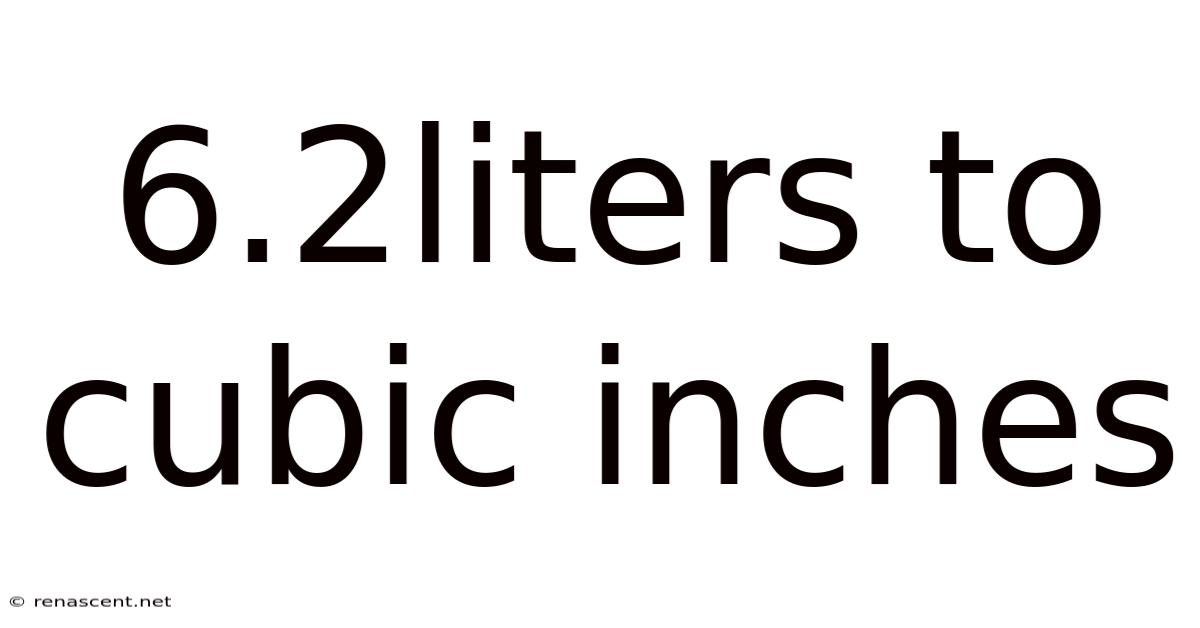6.2liters To Cubic Inches
renascent
Sep 15, 2025 · 5 min read

Table of Contents
Converting 6.2 Liters to Cubic Inches: A Comprehensive Guide
Many car enthusiasts and mechanics often encounter the need to convert between metric and imperial units, particularly when dealing with engine displacement. This article will provide a thorough explanation of how to convert 6.2 liters to cubic inches, exploring the underlying principles, offering multiple calculation methods, and addressing frequently asked questions. Understanding this conversion is crucial for comparing engine sizes across different vehicle manufacturers and regions. We will delve into the mathematical process, explore the practical implications, and clarify any potential misunderstandings. Let's dive in!
Understanding Units of Volume
Before we begin the conversion, let's refresh our understanding of the units involved. Liters (L) are a metric unit of volume, while cubic inches (in³) are an imperial unit. The key difference lies in their base units: liters are based on the meter (a unit of length), while cubic inches are based on the inch (another unit of length). One liter is defined as the volume of a cube with sides of 10 centimeters (or 0.1 meters). A cubic inch, conversely, is the volume of a cube with sides of one inch. This fundamental difference necessitates a conversion factor to move between these systems.
Method 1: Using the Direct Conversion Factor
The most straightforward method involves using the established conversion factor between liters and cubic inches. One liter is equivalent to approximately 61.0237 cubic inches. Therefore, to convert 6.2 liters to cubic inches, we simply multiply:
6.2 liters * 61.0237 in³/liter ≈ 378.54654 cubic inches
Therefore, 6.2 liters is approximately 378.55 cubic inches. This method provides a quick and accurate result, but understanding the underlying principles enhances comprehension.
Method 2: Step-by-Step Conversion Using Cubic Centimeters
This method provides a more detailed understanding of the conversion process by breaking it down into smaller steps. We'll leverage the fact that 1 liter equals 1000 cubic centimeters (cm³).
-
Convert liters to cubic centimeters:
6.2 liters * 1000 cm³/liter = 6200 cm³
-
Convert centimeters to inches:
There are approximately 2.54 centimeters in one inch. Therefore, to convert cubic centimeters to cubic inches, we need to cube this conversion factor: (2.54 cm/in)³ = 16.387 cm³/in³
-
Convert cubic centimeters to cubic inches:
6200 cm³ * (1 in³/16.387 cm³) ≈ 378.54 cubic inches
This method confirms the result obtained using the direct conversion factor. The slight difference is due to rounding during the calculations. This approach highlights the relationship between different metric and imperial units of volume.
Understanding the Significance of Engine Displacement
Engine displacement, often expressed in liters or cubic inches, represents the total volume of all the cylinders in an engine. A larger displacement generally indicates a more powerful engine, capable of producing more torque and horsepower. However, other factors such as engine design, efficiency, and technology also play significant roles in determining an engine's overall performance. The conversion between liters and cubic inches is essential when comparing engines from different manufacturers or regions, as some manufacturers might prefer to use one unit over the other.
Practical Applications of the Conversion
Understanding the conversion between liters and cubic inches has practical applications beyond simply comparing engine sizes. For instance:
- Automotive Repair and Maintenance: Mechanics need to understand engine displacement to select the correct parts and perform accurate repairs.
- Engineering and Design: Engineers use this conversion when designing and developing new engines, ensuring compatibility with various components and systems.
- Performance Tuning: Modifying an engine often involves altering its displacement, requiring a precise understanding of these units.
- Vehicle Sales and Marketing: Understanding these units allows for clearer communication about vehicle specifications and features.
Frequently Asked Questions (FAQs)
Q: Is the conversion factor always exactly 61.0237?
A: The conversion factor of 61.0237 is an approximation. The exact conversion depends on the precision of the measurements involved. However, this approximation is accurate enough for most practical purposes.
Q: Why are both liters and cubic inches used?
A: Different regions and industries have historically adopted different units of measurement. The use of both liters and cubic inches reflects this historical usage, although the trend is towards increased standardization using the metric system.
Q: Can I use online converters for this calculation?
A: Yes, many online converters are available, providing a quick and easy way to perform this conversion. However, understanding the underlying principles is crucial for ensuring accurate interpretation of the results and handling more complex conversions.
Q: Are there other units of volume I might encounter?
A: Yes, other units of volume include gallons, quarts, pints, milliliters, and cubic centimeters, among others. Knowing how to convert between these units is valuable in various contexts.
Q: How accurate does the conversion need to be?
A: The required accuracy depends on the application. For general comparison purposes, the approximation of 61.0237 in³/liter is sufficient. However, more precise calculations might be needed in engineering or scientific contexts.
Conclusion
Converting 6.2 liters to cubic inches is a fundamental calculation with practical applications in various fields, particularly in the automotive industry. This article has explored two methods for performing this conversion, highlighting the importance of understanding the underlying units and conversion factors. The approximate result of 378.55 cubic inches provides a clear understanding of the equivalent volume in the imperial system. By understanding the different approaches and their implications, you'll be better equipped to handle similar conversions and appreciate the interconnectedness of different measurement systems. Remember that while online converters are readily available, a grasp of the underlying principles ensures a deeper understanding and greater confidence in your conversions.
Latest Posts
Related Post
Thank you for visiting our website which covers about 6.2liters To Cubic Inches . We hope the information provided has been useful to you. Feel free to contact us if you have any questions or need further assistance. See you next time and don't miss to bookmark.